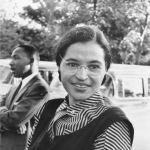The answer is not so much about what Rosa Parks did – it was what she didn’t do that set a series of events in motion that finally led to the end of segregation on all busses in Alabama.
Rosa Parks’ Arrest
Rosa Parks got arrested on a municipal Montgomery bus on December 1, 1955, when heading home after work. The reason: she refused to give up her seat so a single white man could have a whole row of four seats to himself. Rosa Parks said that she did not get on that bus planning to cause a scene and get arrested, she was just sick and tired of the unfair treatment Black Americans have been getting.
Segregation System on Alabama Buses
Alabama laws at the time of the bus boycott specified that the front portion of the bus was to be reserved for white citizens and the back of the bus for blacks. Although the law didn’t state so explicitly, bus drivers would require black people in the rows directly behind the white section to get up and give up their seats for white people if the front section was full. They also had to clear a whole row even if only one white person needed a seat. If the bus was full, the black people would have to stand.
African Americans were often required to pay their bus fees, which were the same rate as that of the whites, at the driver in the front and then get out, move to the back of the bus and get back in through the back door. If they were too slow, the bus driver would often take off with their money, and leave them standing on the sidewalk. Rosa Parks was a well-respected member of her community, so when the other African Americans in Montgomery got word about her arrest, they were outraged. Even though 70 percent of all people using the municipal buses were black, whites were getting preferential treatment.
The Montgomery Bus Boycott
After her arrest and release on bail, Rosa Parks had to appear in court. Her trial only lasted about 30 minutes. The verdict: guilty. In the meantime, a friend of Parks, E.D. Nixon (president of the NAACP in Montgomery) asked Rosa if she would be willing to take part in a lawsuit against the company. She agreed.
Just after Rosa’s arrest, outraged bus-users organized a one-day boycott of the Montgomery buses. This boycott was very successful and turned into a 381-day boycott led by Martin Luther King Jr. The boycott ended with the Supreme Court ruling that the bus segregation laws were unconstitutional, a victory for the Civil Rights movement. Parks kept fighting for civil rights after this; the bus boycott had set the example for non-violent protests in the U.S.
This article is part of our extensive resources on black history. For a comprehensive article on black history in the United States, click here.
Cite This Article
"What Did Rosa Parks Do?" History on the Net© 2000-2024, Salem Media.
July 27, 2024 <https://www.historyonthenet.com/what-did-rosa-parks-do>
More Citation Information.







